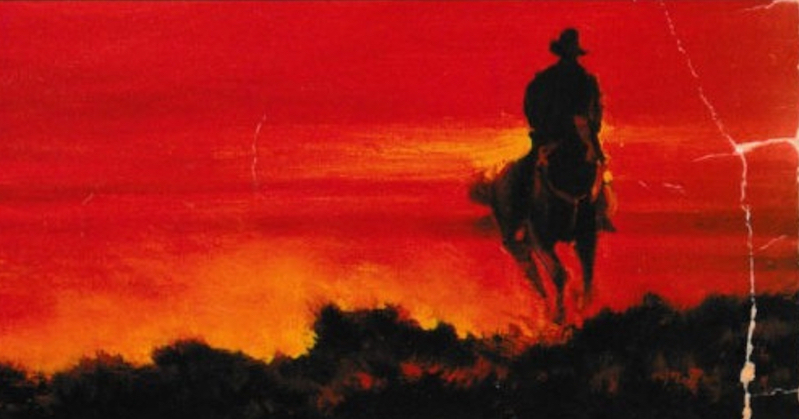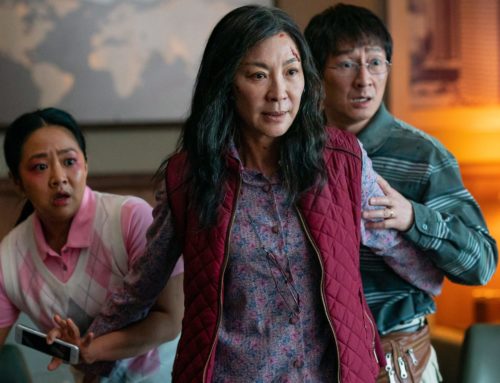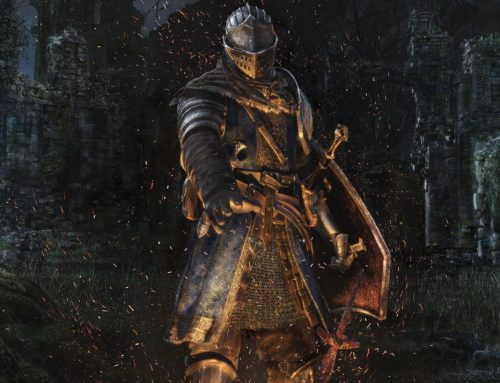Ever wanted to read a western about a gang of outlaws murdering and scalping innocent civilians, women and children included? No? How about westerns? Do you like westerns? If yes, then stick around, because Cormac McCarthy’s Blood Meridian or the Evening Redness in the West is one of them westerns, published in 1985. Though be warned – it does feature copious amounts of murdering and scalping, described in exquisite detail.
Unlike most entries in this genre, Blood Meridian is less concerned with heroics and adventure and more with deconstructing, and perhaps, even critiquing the genre itself, particularly its obsession with lawlessness and violence. So, if you’ve been searching for a novel about horrible people doing horrible things, who sometimes discuss philosophically poignant aspects of their existence, in between equally philosophically poignant landscape descriptions, then you might’ve just discovered your favorite book. It’s so good, in fact, that well-known literary critic Harold Bloom has called it “the ultimate western, not to be surpassed” (even by McCarthy himself).
As a fan of dark fantasy, such as A Song of Ice and Fire by George R.R. Martin and The First Law by Joe Abercrombie, I loved this depraved masterpiece. Though, to be fair, in terms of themes and prose, it’s more akin to Melville’s Moby-Dick and Faulkner’s The Sound and the Fury (meaning it’s not exactly an easy read).
That said, if dark stories are your cup of tea, then don’t miss out on Blood Meridian. Here’s why you shouldn’t:
The Story
Blood Meridian follows a nameless protagonist referred to as the “kid” – or the Kid, for our purposes here – a young man with a penchant for violence, who joins a gang of outlaws led by John Joel Glanton (a real guy, apparently), and his right-hand man (of sorts), Judge Holden – or the Judge (another real guy, apparently). Originally hired to fend off the Apache marauders around the Mexico-US border, the Glanton gang eventually begins slaughtering innocent Mexicans and Indians – entire settlements of them – both for fun and profit.
In between these vividly imagined carnages, the Kid has conversations with various members of the gang, the most prominent of whom is the aforementioned Judge, a man described as large, pale and entirely hairless. He smiles often, appearing almost irreverent, and is compared to an infant. Like everyone in the gang, he regularly engages in violence and slaughter. However, unlike his peers, he doesn’t just enjoy the violence, he actively defends it, identifying it as a kind of primordial right that he and every living creature share. To him, all of life is locked in an eternal war. In a state of constant struggle, between life and death. That’s why he encourages Glanton and the rest to keep doing what they’re doing. It’s their destiny, in a way.
Here’s how the Judge speaks of war:
War was always here. Before man was, war waited for him. The ultimate trade awaiting its ultimate practitioner.
He also detests those who are unwilling to partake in this “war.” And the “dance” of war. Here’s his view on that:
As war becomes dishonored and its nobility called into question those honorable men who recognize the sanctity of blood will become excluded from the dance, which is the warrior’s right, and thereby will the dance become a false dance, and the dancers false dancers. And yet there will be one there always who is a true dancer and can you guess who that might be?
…
Only that man who has offered up himself entire to the blood of war, who has been to the floor of the pit and seen horror in the round and learned at last that it speaks to his inmost heart, only that man can dance.
Each member of the Glanton gang appears to have met the Judge, at one point or another, before joining, and the Kid is no exception. The Kid meets the Judge at a sermon, during which the Judge accuses the preacher there of pedophilia and bestiality, prompting everyone to confront him (violently). He does this, seemingly, for his own amusement.
If you’ve seen Coen Brothers’ adaptation of McCarthy’s No Country for Old Men, you should be familiar with its chief antagonist, Anton Chigurh (played by Javier Bardem). He and the Judge are quite similar. They’re both extremely deadly and they both view violence as something beyond them – a force of nature, for which they are mere conduits. In addition, both characters appear to be supernatural. The Judge never ages, for example, while Chigurh seems to be unkillable. Some have called the Judge Satan in human form, but I’ll leave that up to you.
At this point, you may be wondering why I’m spending so much time on this Judge character when I should be talking about the story. That’s because he is the story. Or at least, a major focal point, since there’s hardly any “plot.” The basic events are what I’ve already described – the Kid and the Glanton gang wander from place to place, typically across a hot, lifeless desert, and murder innocents with increased regularity. It’s the Judge who holds the narrative together, through his speeches, which attempt to justify and explain all this mayhem.
While the violence in Blood Meridian can, at times, be “entertaining” – in a morbid sort of way – it’s not the draw. The violence is meant to repulse. To offend. It’s casual, senseless, and ultimately, grotesque. That’s why the Judge is pivotal. He gives reason to the madness. To the nihilism of it all, even if his “wisdom” is questionable at best.
And that’s kind of the central tension of the novel. When and how will the nightmare end? Who will come out on top? Will it be the Judge? Glanton? The Kid? I won’t spoil it for you, but brace yourself for a super-intense climactic sequence and a gut punch of an ending that makes it all worth it.
The Protagonist: The Kid
There’s even less to say about the Kid than Shadow, the arguably bland protagonist of American Gods, a book I’ve recently reviewed.
We don’t get to learn much about the Kid, save for the fact that he seems to be drawn to violence – though not in a sadistic way, like the Judge. Violence simply finds him, and he’s often eager to partake in it. Since he doesn’t come from wealth, he joins the Glanton gang – to make money and to sate his thirst for violent misadventures.
As the novel progresses, the Kid develops animosity toward the Judge, but in spite of it, he still doesn’t leave the gang – or openly condemn its awful actions – so it’s not entirely clear where he stands morally. There are moments where he appears more compassionate than others, but only toward his fellow gang members, not the victims of the gang’s exploits.
If you were to ask me deeper questions about the Kid’s psychology, I wouldn’t be able to answer them. McCarthy doesn’t give us much on what the Kid thinks or feels. All we see are his actions – physical and verbal. He doesn’t even have that much dialogue, since it’s the Judge who often takes center stage.
In many ways, the Kid is a blank-slate protagonist. There’s a lot of room for reader projection and interpretation. You can view him as a boy who ends up lost and tricked into this lifestyle, or as a sociopath, who has deliberately sought out this path for himself. There’s no clear indication of where he falls on this spectrum. Personally, I think it’s a mix of both. He’s lost, but he’s also drawn to violence, and perhaps, on some level, he enjoys it more than he’s willing to admit.
The most peculiar aspect of the book – and this is where Blood Meridian differs from McCarthy’s other works – is that the Kid is absent from many sequences, particularly the gang’s violent excursions. Instead, McCarthy gives us the broader picture, of the carnage itself, and occasionally, follows other members of the gang as they kill, rape and plunder. The Kid himself is either barely mentioned or not mentioned at all, which leaves his motives (and activities) up to your imagination.
And that’s really all there is to the Kid. On the surface, at least. The rest you can dig up yourself when you read the book.
The Writing
As soon as you start reading Blood Meridian, or any McCarthy book for that matter, you’ll instantly notice how odd and distinct his prose style is.
Let’s start with the obvious – the punctuation. Perhaps you’ve heard some claim that McCarthy doesn’t use any punctuation at all.
That’s a lie. What he doesn’t do is use certain kinds of punctuation. He doesn’t use quotation marks for example. Instead, dialogue appears like any other text. Plain. What clues you in that you’re reading dialogue are the tags (e.g. “he said/she said”) and a change in writing style.
McCarthy’s prose outside of dialogue is full of long, archaic-sounding sentences (described as “biblical” by several critics). His dialogue, conversely, is terse and seemingly unremarkable, often incorporating geographically appropriate dialect (and in some cases, a different language altogether, such as Spanish). The Judge is the exception to this rule, as he appears to speak more closely to the way McCarthy writes.
Here’s a dialogue snippet, to give you an idea of what the dialogue looks like on the page:
Books lie, [the judge] said.
God dont lie.
No, said the judge. He does not. And these are his words.
He held up a chunk of rock.
He speaks in stones and trees, the bones of things.
The squatters in their rags nodded among themselves and were soon reckoning him correct, this man of learning, in all his speculations, and this the judge encouraged until they were right proselytes of the new order whereupon he laughed at them for fools.
You’ll notice that despite the lack of quotation marks, the dialogue is still relatively easy to follow. That’s definitely something McCarthy excels at. He uses paragraphs, distinct character voices and dialogue tags to keep you appraised of who’s saying what at any given time.
Commas tend to be excluded in most cases and replaced with the word “and.” However, just by examining the snippet above, you can tell he still uses commas, and never neglects a period. He also uses colons for lists, and sometimes, he italicizes specific sentences, paragraphs and words (though this is not, technically speaking, punctuation). What he doesn’t use at all – in addition to quotation marks – are semi-colons, but that’s hardly unusual.
McCarthy’s sentences tend to be long, but not always, as he does alternate between lengthy, descriptive passages such as this one:
In the neuter austerity of that terrain all phenomena were bequeathed a strange equality and no one thing nor spider nor stone nor blade of grass could put forth claim to precedence. The very clarity of these articles belied their familiarity, for the eye predicates the whole on some feature or part and here was nothing more luminous than another and nothing more enshadowed and in the optical democracy of such landscapes all preference is made whimsical and a man and a rock become endowed with unguessed kinship.
And simple phrases like “they rode on.”
You’ll also notice that he uses a lot of familiar words in unfamiliar word combinations, such as “optical democracy.” Because of this, Blood Meridian reads almost like an ancient text. One that predates our modern linguistic sensibilities, almost like the Bible. Hence, “biblical,” I guess. This gives the novel an aura of mysticism, as though it had been written by God himself, or someone with a deep connection to God – or another primordial force. Maybe the universe itself.
Another big peculiarity when it comes to McCarthy’s writing is that he never describes character thoughts. What you see, visually, is what you get, sort of like in a movie. Thus, visual descriptions and character actions (including dialogue) are the sole drivers of the story, which means you need to be extra-attentive to grasp the full picture.
It’s worth mentioning that in terms of text density and complexity, Blood Meridian is one of McCarthy’s most ambitious works. So, if you haven’t read anything by him, or are used to “simpler” books, I recommend picking up his other works first, such as The Road or the Border Trilogy (which includes All the Pretty Horses, The Crossing and Cities of the Plain). The ones I would leave for last are Blood Meridian and Suttree (another terrific novel).
On the other hand, if you’ve read difficult authors like Melville, Faulkner or Joyce, then Blood Meridian should be a walk in the park.
Common Complaints (Debunked)
Nothing’s ever perfect, and Blood Meridian isn’t either. However, there are some complaints that are unwarranted, or seem to be based on false expectations. Let me go through them and attempt to debunk them:
1. There’s no plot, and therefore it’s boring!
A complaint levied at plenty of classic works, particularly literary ones. To an extent, this is correct. There is no intricate plot in Blood Meridian. If you’re used to stories like A Game of Thrones or Harry Potter, which feature tons of twists, hidden agendas and so forth, then this may not impress you. However, that doesn’t mean you won’t find a worthy story here.
First of all, there is, in fact, a plot here. It’s just that for several hundreds of pages, it doesn’t seem to progress – mainly in the second act. And yes, you can divide this book into three acts. Act one introduces us to the Kid and his struggles as a youth and concludes with him joining the Glanton gang. Act two follows the gang’s exploits along the Mexico-US border. And act three is the climax, which I won’t spoil here.
When speaking of the book’s plot, many focus on the second act, which, admittedly, does consist of three things – violent massacres, long trips across the desert and poignant dialogue scenes, usually involving the Judge. However, these are all so expertly written that to call them “boring” is to miss the point entirely. All three of these elements – violence, descriptions and dialogue – tie together perfectly on a thematic level. You just have to pay attention to each of them, and pause and think as you read.
Plus, the action sequences are so depraved that it’s hard not to enjoy them at least on some level, particularly if you’re into grimdark.
Finally, the climax is worth the struggle, as is the ending. It practically begs you to reread the whole thing from the start and dig deeper to find clues and other cool tidbits. And find them you will, I guarantee it. Once you get into this book, you’ll really get into it, and then you won’t shut up about it.
2. All characters are paper-thin, except the Judge!
Okay, so again, this isn’t exactly wrong. The Kid isn’t much of a protagonist, and he’s missing for large stretches of the text (despite being physically there for most of the events). The other gang members, including the Judge, aren’t particularly deep either, at least on the psychological level. As I’ve mentioned before, McCarthy isn’t big on describing character thoughts. Therefore, everything is visual. Or at least, presented visually. The dialogue also plays a role in giving you an understanding of the characters. But that’s about it.
As a result, you have to do a lot of work to understand what the characters are up to mentally or emotionally. You’ll have to read this carefully. Slowly. And you’ll have to reread certain parts as well.
That said, I wouldn’t say that individual characters are the focus here. The focus is the landscape itself – the vast desert upon which much of the action takes place – and how it intertwines with what the characters do (aka despicable violence). If you accept the work as this, you’ll find plenty to be fascinated by.
3. Too much traveling around! Too many descriptions!
There is a lot of traveling and a lot of description, yes. But none are pointless. Everything you see contributes to the overarching themes and ideas of the novel. This approach isn’t for everyone, I’ll admit, but if slower-paced, more descriptive books are your thing (like A Game of Thrones, for instance), then I think you’ll find much to admire here.
My Own Complaints
So, what do I not like about this book? I do think the text can be too dense at times, which combined with the repetitive nature of the second act can be a little grating. Some passages tend to run far longer than they should – or at least, feel they should – making it seem as though McCarthy is too in love with his own linguistic prowess. But these are just minor nitpicks, more than anything else. Like I said, nothing is perfect.
In Conclusion… Read This Book!
Blood Meridian is a literary classic for a reason. And if you’re waiting for it to become a movie, then you might be waiting a long time, as the adaptation doesn’t seem likely.
So, stop waiting and give this book a read. Even if you walk away disappointed by its plot and characters, you’re still likely to feel accomplished for having read it. You may also pick up a few new words and phrases, which you can then use on your unsuspecting friends and relatives. Really, there are not downsides to picking this up, so do it! Today!




